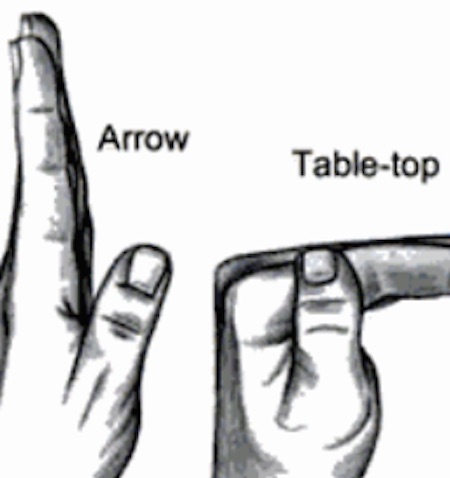Ganglion Cysts
What are ganglion cysts?
Ganglion cysts are very common lumps within the hand and wrist that occur adjacent to joints or tendons. The most common locations are the top of the wrist (see Figure 1), the palm side of the wrist, the base of the finger on the palm side, and the top of the end joint of the finger (see Figure 2). The ganglion cyst often resembles a water balloon on a stalk (see Figure 3), and is filled with clear fluid or gel. The cause of these cysts is unknown although they may form in the presence of joint or tendon irritation or mechanical changes. They occur in patients of all ages. These cysts may change in size or even disappear completely, and they may or may not be painful. These cysts are not cancerous and will not spread to other areas.
How are ganglion cysts diagnosed?
The diagnosis is usually based on the location of the lump and its appearance. They are usually oval or round and may be soft or very firm. Cysts at the base of the finger on the palm side are typically a very firm, pea sized nodule that is tender to applied pressure, such as when gripping. Light will often pass through these lumps (trans illumination) and this can assist in the diagnosis. Your physician may request x rays in order to investigate problems in adjacent joints. Cysts at the end joint of the finger frequently have an arthritic bone spur associated with them.
What are the treatment options for ganglion cysts?
Treatment can often be non surgical. In many cases, these cysts can simply be observed, especially if they are painless, as they frequently disappear spontaneously. If the cyst becomes painful, limits activity, or is otherwise unacceptable, several treatment options are available. The use of splints and anti inflammatory medication can be prescribed in order to decrease pain associated with activities. An aspiration can be performed to remove the fluid from the cyst and decompress it. This requires placing a needle into the cyst, which can be performed in most office settings. Aspiration is a very simple procedure, but recurrence of the cyst is common. If non surgical options fail to provide relief or if the cyst recurs, surgical alternatives are available. Surgery involves removing the cyst along with a portion of the joint capsule or tendon sheath (see Figure 3). In the case of wrist ganglion cysts, both traditional open and arthroscopic techniques usually yield good results. Surgical treatment is generally successful although cysts may recur. Your surgeon will discuss the best treatment options for you.
© 2006 American Society for Surgery of the Hand...(taken adapted modified from the ASSH website)
Additional resources and information:
PURPOSE:The aim of this case series report is to assess the effectiveness of aspiration and injection of triamcinolone acetonide for treatment of wrist synovial cysts in children.
METHODS:Twenty-one records of pediatric patients with synovial cyst on the wrist treated with aspiration and triamcinolone acetonide injection were selected for analysis of their outcomes. All cases were aspirated and injected at the operating room under mask induction anesthesia. Three categories were used to classify the patients' outcomes: (1) successful treatment with no recurrence, (2) successful treatment with residual sclerotic lump, and (3) recurrence of cyst.
RESULTS:Fourteen females and 7 males with an average age of 7.2 years had a mean time with the cyst of 1 year. All children were asymptomatic. After aspiration, 13 (62%) of 21 patients experienced successful treatment of the synovial cyst with no recurrence after a single intervention. Five patients had a residual lump at the site of the cyst (24%), which disappeared after an average of 6 months. Three patients experienced true recurrence of the synovial cyst (14%). Average follow-up was 2.5 years.
CONCLUSIONS:Aspiration and injection of triamcinolone accounted for a considerable reduction in recurrence. Aspiration and triamcinolone acetonide injection of wrist synovial cysts is an effective and safe treatment that may be considered as first-line treatment in the pediatric population if there is no resolution after 1 year of observation.
Ganglion Cysts
A brief overview of what patients may expect during the treatment of ganglion cysts of the hand and wrist.
NOTE: Actual surgery is part of this video
VIDEO from handcare.org the American Society for Surgery of the Hand





 copy.jpg)
